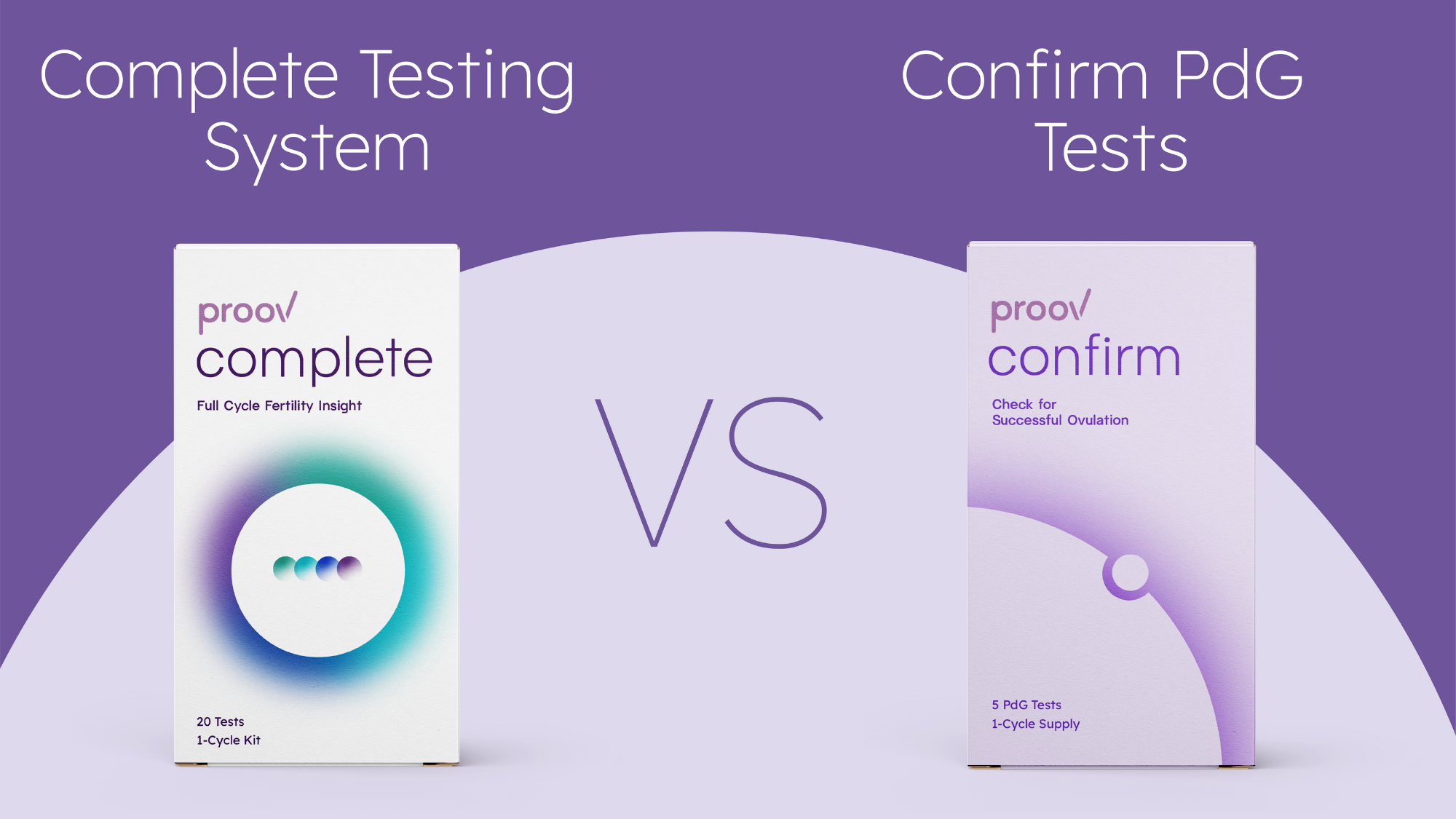Fertility can be a confusing topic, especially when you're trying to conceive.
One of the important aspects of understanding your fertility is knowing if you're ovulating properly.
This is where PDG testing comes in.
In this blog, we'll explore what PDG testing is, how it works, and why it’s essential.
We’ll also look at the Proov Complete Testing System, how to interpret PDG test results, and how it compares to other PDG tests.
Key Takeaways
- PDG testing measures Pregnanediol Glucuronide in urine to confirm ovulation and adequate progesterone levels, essential for supporting early pregnancy.
- It is best to test PDG levels 7-10 days after suspected ovulation using first-morning urine for accurate results.
- The Proov Complete Testing System offers a comprehensive view by tracking multiple hormones, providing detailed insights into fertility compared to basic at-home test strips.
- A positive PDG test indicates successful ovulation and sufficient progesterone, while a negative test may suggest issues with ovulation or hormone levels.
- Understanding and interpreting PDG test results can help monitor fertility and assess the effectiveness of fertility treatments.
What is a PDG Test?
A PDG test measures the levels of Pregnanediol Glucuronide in your urine.
PDG is a metabolite of progesterone, a hormone crucial for maintaining the lining of the uterus and supporting early pregnancy.
By measuring PDG, you can confirm that ovulation has occurred and that your body is producing enough progesterone to support a potential pregnancy.
How Does the PDG Test Work?
Understanding PDG Levels
After ovulation, the empty follicle (corpus luteum) produces progesterone.
Some of this progesterone gets converted into PDG, which is then excreted in urine.
Testing for PDG levels in urine can confirm that ovulation has taken place and that the body is producing adequate progesterone.
The Testing Process
Sample Collection
Typically, PDG tests are taken using first-morning urine samples, as this is when PDG levels are most concentrated.
Applying the Sample
The urine sample is put onto a test strip or cartridge, which contains chemicals that react with PDG.
Reading the Results
After a specified time, usually a few minutes, the test strip or cartridge displays the result, indicating the presence and level of PDG.
Why Should You Test PDG?
Confirming Ovulation
PDG testing is an excellent way to confirm that ovulation has occurred.
This can be particularly useful for women who have irregular cycles or are unsure if they are ovulating.
Ensuring Adequate Progesterone Levels
Progesterone is essential for keeping the uterine lining and supporting early pregnancy.
By testing PDG, you can ensure that your body is producing enough progesterone to support a pregnancy.
Monitoring Fertility Treatments
For women undergoing fertility treatments, PDG testing can help monitor the effectiveness of medications that induce ovulation and support progesterone levels.
How to Test for PDG
When to Test
PDG levels are best tested about 7-10 days after suspected ovulation.
This is when levels should be high enough to confirm ovulation and adequate progesterone production.
Types of PDG Tests
There are several types of PDG tests available, ranging from simple at-home test strips to more advanced digital monitors.
The choice of test depends on your personal preference and needs.
Step-by-Step Testing Guide
- Determine Testing Days: Based on your cycle, identify the best days to test for PDG.
- Collect First-Morning Urine: Use first-morning urine for the most accurate results.
- Apply Urine to Test Strips: Follow the instructions in your test kit.
- Wait for Results: Wait the specified time and then read the results.
Testing Methods
At-Home PDG Test Strips
These are simple, affordable, and widely available. They involve dipping a test strip into a urine sample and waiting for the results.
Digital PDG Monitors
Digital monitors offer more precise readings and can store data over time, providing a more comprehensive overview of your fertility.
Proov Complete Testing System
The Proov Complete Testing System is a comprehensive at-home test kit designed to monitor multiple hormones, including PDG, to give a complete picture of your fertility.
Features
- Easy-to-Use: The Proov system is user-friendly, with clear instructions and easy-to-read results.
- Comprehensive Monitoring: It tracks multiple hormones, providing a detailed understanding of your ovulation and fertility health.
- Accurate Results: Proov uses advanced technology to ensure correct and reliable results.
PDG Test Results and Interpretation
Positive PDG Test
A positive PDG test indicates that ovulation has occurred and that your body is producing adequate progesterone. This is a good sign for fertility and early pregnancy support.
Negative PDG Test
A negative PDG test may suggest that ovulation has not occurred or that progesterone levels are not high enough. This can be a signal to consult a healthcare provider.
Interpreting the Results
- High PDG Levels: Confirm ovulation and adequate progesterone production.
- Low PDG Levels: This may indicate an ovulation or progesterone production issue.
Comparing Proov Complete Testing System vs. Other PDG Tests
Ease of Use
The Proov system is designed to be user-friendly, with clear instructions and easy-to-read results. Other PDG tests may require more interpretation or additional steps.
Accuracy
Proov uses advanced technology to ensure high accuracy, whereas some at-home test strips may have more variability in their results.
Comprehensive Monitoring
Unlike basic PDG test strips, the Proov system monitors multiple hormones, providing a more comprehensive view of your fertility.
Understanding Fertility vs. Ovulation
Fertility
Fertility refers to your overall ability to conceive and have a healthy pregnancy. It involves many factors, including hormone levels, reproductive health, and overall health.
Ovulation
Ovulation is the process of giving an egg from the ovary. It is a crucial part of fertility, but ovulation alone does not guarantee fertility.
The Relationship Between Fertility and Ovulation
While ovulation is essential for fertility, other factors such as hormone balance, uterine health, and lifestyle also play significant roles.
FAQs
What Does a Positive PDG Test Mean?
A positive PDG test means that ovulation has occurred and your body is producing adequate progesterone. This is a good sign for fertility and early pregnancy support.
How Often Should You Test for PDG?
You should test for PDG about 7-10 days after suspected ovulation. Testing can be done over a few days to confirm consistent progesterone production.
Can PDG Levels Vary?
Yes, PDG levels can vary throughout the day and cycle. It's important to follow the testing instructions carefully for the most accurate results.
The Bottom Line
Understanding PDG testing and using tools like the Proov Complete Testing System can provide valuable insights into your fertility and ovulation.
By knowing how to test for PDG, interpret the results, and use comprehensive monitoring systems, you can take proactive steps in your fertility journey.
Whether you are trying to conceive or monitoring your reproductive health, PDG testing is an essential tool to help you achieve your goals.













